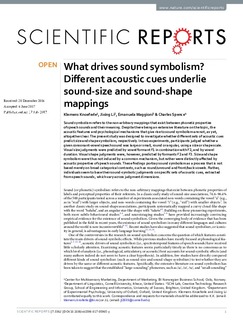What drives sound symbolism? Different acoustic cues underlie sound-size and sound-shape mappings
Journal article, Peer reviewed
Accepted version
Permanent lenke
http://hdl.handle.net/11250/2461995Utgivelsesdato
2017Metadata
Vis full innførselSamlinger
- Publikasjoner fra CRIStin - BI [1015]
- Scientific articles [2181]
Sammendrag
Sound symbolism refers to the non-arbitrary mappings that exist between phonetic properties of speech sounds and their meaning. Despite there being an extensive literature on the topic, the acoustic features and psychological mechanisms that give rise to sound symbolism are not, as yet, altogether clear. The present study was designed to investigate whether different sets of acoustic cues predict size and shape symbolism, respectively. In two experiments, participants judged whether a given consonant-vowel speech sound was large or small, round or angular, using a size or shape scale. Visual size judgments were predicted by vowel formant F1 in combination with F2, and by vowel duration. Visual shape judgments were, however, predicted by formants F2 and F3. Size and shape symbolism were thus not induced by a common mechanism, but rather were distinctly affected by acoustic properties of speech sounds. These findings portray sound symbolism as a process that is not based merely on broad categorical contrasts, such as round/unround and front/back vowels. Rather, individuals seem to base their sound-symbolic judgments on specific sets of acoustic cues, extracted from speech sounds, which vary across judgment dimensions.
Beskrivelse
This is an Open Access journal available from www.nature.com
